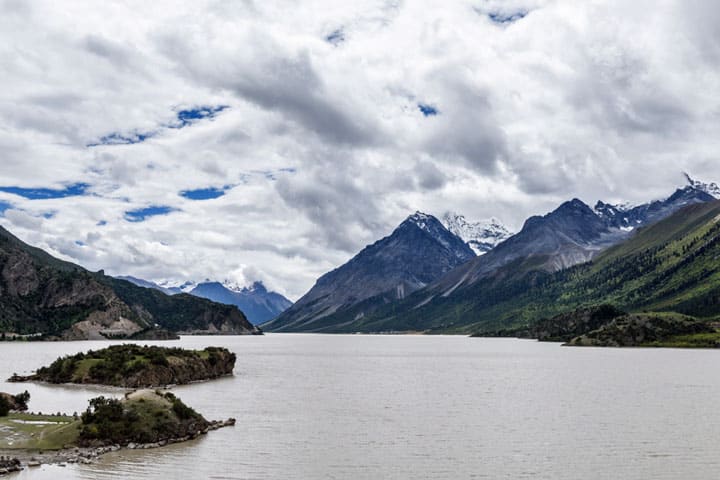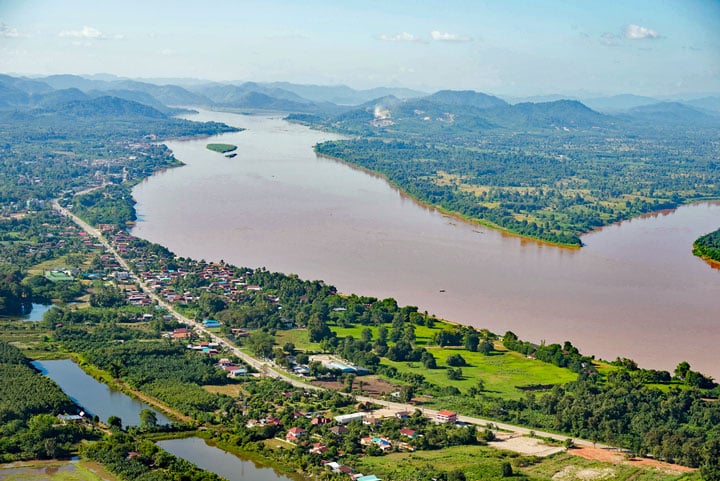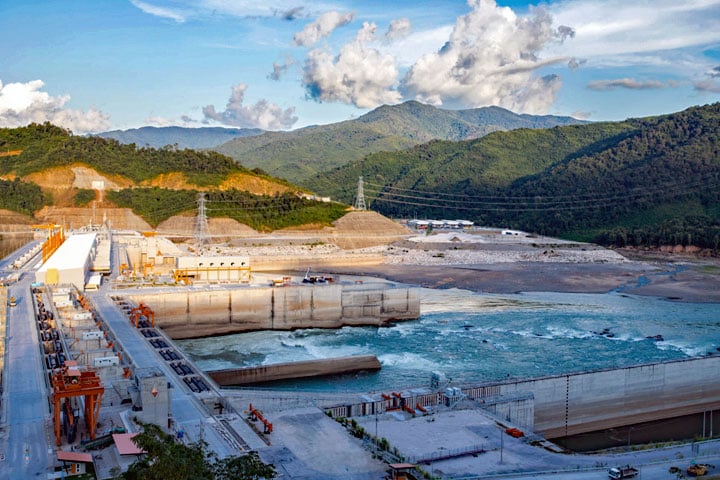The Mekong increasingly threatened by boundless ambition

The Tibetan Plateau at Chamdo
Earlier on Thailand blog I pointed out the exceptional importance of the Mekong, one of the most famous and notorious rivers in Asia. However, it is not just a river, but a waterway loaded with myths and history.
The stream rises high on the Roof of the World, in the perpetual snows of the Tibetan plateau near Chamdo, and flows through the People's Republic of China, Burma, Laos, Thailand, Cambodia and Vietnam before deflating more than wall-to-wall after 4.909 km. mouths in the South China Sea. This mighty stream is the unmistakable lifeblood of a region that gave birth to and buried some of the world's most fascinating civilizations and cultures.
The fragile ecosystem of the Mekong is today threatened by extremely low water levels. Experts predict that Thailand, Cambodia, Laos and Vietnam will have to take into account a period of exceptional drought at least until February and maybe even March 2020. A water shortage that will undoubtedly have a major and negative impact on, among other things, fishing, but certainly also on agricultural production that is dependent on irrigation by the Mekong and its tributaries, which is estimated to feed 60 million people.
The drought, which is partly the result of a very poor rainy season, has caused the lowest water level on the stream in 60 years. In a normal year, the rainy season in the Mekong basin starts in the last weeks of May and ends in October. This year it started three weeks late and ended almost a month early… The consequences were not long in coming. The Mekong River Commission which was established 24 years ago as an international agency for the water management and sustainable management of this stream, sounded the alarm in June about the extremely low water level in the normally wide-spreading Mekong Delta in South Vietnam.

Mekong River at Nong Khai
At the moment, at the end of November, the situation has not improved, partly due to unexpectedly high temperatures in the region, on the contrary. The members of the River Commission now assume that the situation will worsen in the next two or three months, with Thailand and Cambodia, in comparison with Laos and Vietnam, being hit the hardest. Large parts of Thailand and Cambodia have already been victims of water shortages and drought in recent months, but an additional period of drought is now expected for the coming weeks and months, which will put even more pressure on the fragile and precious fabric of the Mekong's ecosystem. to make. I can see it with my eyes, because in my backyard runs the Mun, the longest Thai tributary of the Mekong. What has never happened before, you can now just walk ankle-deep in the water, and sometimes even just step from sandbank to sandbank, from one bank to the other….
However, the lack of rain is not the only cause of the extremely low water level. The main threat is undoubtedly formed by the construction of a number of dams on the Mekong and a number of tributaries. Maintenance work at the huge hydroelectric power station of Jinghong in China's southern province of Yunnan, which pushed up the water of the Mekong for two weeks in July, and tests at the equally immense Xayaburi Dam in Laos appear to be partly responsible for the alarmingly low water levels. Thailand even protested publicly against the tests at the Xayaburi Dam, which is quite bizarre in itself when one knows that it is precisely the Thai state-run Electricity Generating Authority of Thailand (EGAT) is the main client for the construction of this hydroelectric power station…

Xayaburi Dam in Laos
Many experts point an accusing finger at the communist rulers in the Laotian capital Vientiane. More than ten years ago, they realized that generating electricity through hydropower could bring in a lot of money. In an effort to 'Battery of Asia' a series of ambitious, mostly China-led, damming projects and the construction of massive hydroelectric power plants began. Some of these plans are shrouded in secrecy, according to the environmental movement International Rivers Laos would set a target of no less than 72 new dams of which 12 would already be under construction or completed, while more than 20 others would be in the planning stage.
The fact that this unbridled building fury is not without danger became dramatically clear on July 23, 2018. Then part of the dam at the hydroelectric power station on the Xe Pian-Xe Nam Noi near the Sanamxay district in South Laotian Attapeu province collapsed. The clients of this project included the Thai Ratchaburi Electricity Generating Holding, the South Korean Korea Western Power and the Lao state-owned company Lao Holding. Through the hole, a swirling and murderous mass of water estimated at 5 billion cubic meters of water flowed through the villages along the Xe Pian River. The Laotian government, keen to keep the matter under wraps, officially admitted a few days later that 19 people had drowned, several hundred were still missing and 3.000 people had to be evacuated. However, according to United Nations experts, at least 11.000 Laotians were affected by this catastrophe and more than 150 people died… Earlier, on September 11, 2017 to be precise, the water reservoir of a dam under construction on the Nam Ao River in the Phaxay district in Xiangkhouang province collapsed…
The People's Republic of China itself has now completed 11 dams on the Mekong and the construction of 8 more is planned for the coming years. Not only do these megalomaniac infrastructure works threaten water management and safety, but it has also been proven that fish stocks in Laos, Thailand, Cambodia and Vietnam suffer significantly from these projects. For example, it was calculated that in the vicinity of the Theun Hinboum Dam in Central Laos, after the completion of this dam in 1998, the fish catch has been reduced by 70% of the fish stock for the construction of this dam. Or how boundless ambitions are increasingly jeopardizing the future of a viable Mekong…


The new humanity will be amazed and wonder how and who ever built those structures.
This is a terrifying picture of the future…. As long as the citizens involved have no say, little will change.
It all started with the Pak Mun (Paak Moen) dam in the XNUMXs and the fruitless resistance against it by the Assembly of the Poor.
https://www.thailandblog.nl/achtergrond/protestbewegingen-thailand-the-assembly-the-poor/
One of the biggest causes of international tensions, anywhere in the world, will be clean and sufficient water in the future.
There are various (as far as I'm concerned, interesting) articles on the internet about the consequences of the construction of the dams in the Mekong basin and what it can still have. It should be required reading for climate fanatics who all too often have a far too one-dimensional view of how energy needs should be met. The aforementioned decrease in fish is a directly visible consequence, but what about the decrease in (freightable) sediment deposits? Reduction of precisely necessary flooding? And with it erosion of fertile land in the vicinity of that river. So where you solve a problem, you get several in return.
Lung Jan, it stayed with the Mekong, although this in itself is very enough. It was just announced that China only warned neighboring countries after a few days that Mekong water would be saved; the toothless Mekong River Commission can signal but has no power whatsoever.
'Big brother' China also shows elsewhere that fish stocks, irrigation and 'dry feet' at the neighbors don't bother him.
Due to the construction of a dam in the southeastern Himalayas near the border with India, the Brahmaputra, the Irrawaddy and the Salween will be involved and countries such as India, Bangladesh, Myanmar and Thailand will be threatened with alternating water shortages and flooding due to the retention and then release from water. The Salween is also of great importance to Thailand.
For an article on this issue, see https://www.rfa.org/english/news/china/tibet-dam-12032020171138.html
Worrying for all the countries that depend on water from China. The Chinese government has already announced that the water tap will not open again until the end of January, according to the BBC. Their neighboring countries will have to get used to the current situation because it will not get any better. ASEAN, for example, has been paralyzed by Chinese investments in Cambodia, for example, and is therefore unable to take a stand against China.
I saw this problem coming as soon as I heard about the construction of a 1st dam in the Mekong,
The same goes for many rivers around the world where dams are being built.
The countries located downstream can solve this problem in the same way.
By also building dams AND locks in the Mekong!
This way they can hold the water themselves, again.
And the river remains navigable all year round!
For example, “our” good river Maas has been channeled for many years.
And the Maas sometimes has its problems with high water levels.
But it, normally, never falls dry.
The same is partly true for Father Rhine.
The exception was that 4 years ago a tanker rammed the weir at Grave.
As a result, the riverbed partially emptied.
https://nl.wikipedia.org/wiki/Maas
I have no knowledge of water management like WimLex or Mrs. Paay, but if all those dams work together in connection with saving / depositing, then it must be possible, right?
Environmental impacts disregarded for a moment.
Singtoo, did you miss the fact that the Maas can be so low that water can no longer be extracted?
Fairly recent report that 4 (one report, another report says 7 million) million households could get into trouble because of this. One time the river overflows, another time there is no water left.
Which is now being warned about. I wonder what the government will come up with as a solution.
Was surprised yesterday with the announcement that 2 new nuclear power plants are going to be built. Bit late, but better later than never. Although it will soon take 10 years before they are active. Residential building will have to wait a while (N2 emission) and all farmers will be out at a rapid pace. Must be otherwise no nuclear power plants. After all, data centers still have to be built, the entire country is full of them.
As for the Mekong, China can just as easily decide to divert the water to other areas where water is needed for agriculture or for their own population, cities.
They have already done that once to provide Beijing with extra water due to increasing water use in Beijing. Just a pipeline of 100 den kilometers to guarantee water in Beijing.
The Chinese rulers really don't care about others, so it is quite possible that the Mekong will disappear. The Chinese rulers will really not inform, but just do it.
The written article talks about communist rulers, but there are none.
Only capitalist dictators. Not only in China, but in every country.
Democracy, communism, it doesn't exist. Ideological terms from ancient times, which have never had any value.